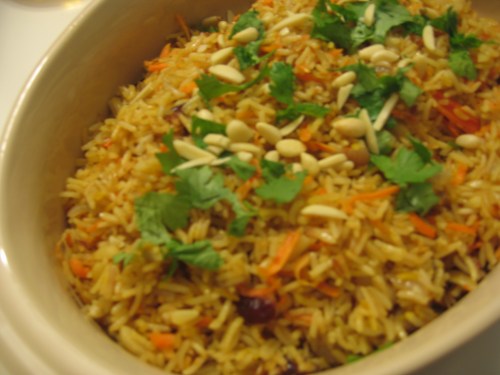Contribute
| Recipes: Ancient Cuisine - Persian Pulow |
12/06/2011
A friend of mine shared this recipe. Persian cuisine is known for the way they cook their long grained rice, their liberal use of saffron, dried lemon, and the combination of meat with fruit and nuts. Saffron or Za'faran is native to Persia. By 500BC, it had spread to India in the east and Egypt in the west. The rulers of the ancient empires really had a good time with this spice. They used it to enhance the flavor of their food, to dye their robes and to perfume their banquet halls. In India, the robes of the elite Buddhist priests were dyed orange with saffron. In Egypt, it is said that Cleopatra used saffron for her complexion. Nero had the streets sprinkled with saffron water to honor his return to Rome. It takes over 80,000 blossoms of crocus to produce one pound of dried saffron. The process of collecting and drying saffron is labor intensive and it is no wonder that it is sold by weight in carats, like gold. The Persians do it slightly differently. They make liquid saffron, and then use that in their polows and beryan. Liquid Saffron Ensure that the saffron is completely dry. If you feel it is not, take 20-30 strands in a mortar and place them in a warm oven for a few minutes.Add a pinch of sugar. And with the pestle, crush the saffron and sugar to a fine powder. If using within an hour or two, add 4-5 tbsp warm water and allow to infuse to a deep orange color. If mixed with boiling water, saffron ground in this manner can be kept in a jar for several weeks. Sabzi Polow Rice with Herbs 2 cups basmati rice 1/8 cup oil or ghee 4 tsp liquid saffron 1 cup of mixed fresh herbs like cilantro, parsley, dill, chives or leeks in equal portions 2 sprigs of fresh fenugreek or 1/2 tsp kasuri methi, optional leaves of 2 fresh garlic or 1 clove of garlic Wash the rice in several changes of water and leave to soak for 3 hours or more. There should be at least 1 inch of water above the rice.Wash and dry the herbs so that they do not have any excess moisture. Bring about 2 quarts of water to a rolling boil in a 3 quart pot or saucepan. Add salt to taste. Drain off excess water from the rice and add it to the boiling water. Bring it back to boil and boil for 2-3 minutes. Test the rice to see if it is soft on the outside and firm in the middle. If it is, drain the water and rinse in warm water. Toss rice gently in a colander. Put the drained out pot back on the stove, add oil and 2-3 tbsp water and heat until it sizzles. Sprinkle a layer of rice along the bottom of the pot. Alternate between a layer of herbs and a layer of rice, building it into a conical shape as you go along. Poke a few holes through the rice to the bottom of the pot using a wooden spoon.Wrap the lid of the pot with a clean kitchen towel and place firmly on the pot. Heat on high for 2-3 minutes and then on low for at least 30 minutes.Take about 2-3 teaspoons of the rice and mix with liquid saffron and reserve this for garnish. Gently toss and mix the rest of the cooked rice and its ingredients to a warmed platter in a symmetrical mound. Garnish with the saffron rice and some melted butter, if you like. Also remove the crusty layer of rice from the bottom of the pot and serve this on a separate platter. Sabzi Polow, is the traditional dish of the spring festival, No Rooz. In India, we are familiar with it as Navroz or the Parsi New Year. from Indian Food Rocks URL: http://www.indianfoodrocks.com
You may also access this article through our web-site http://www.lokvani.com/
